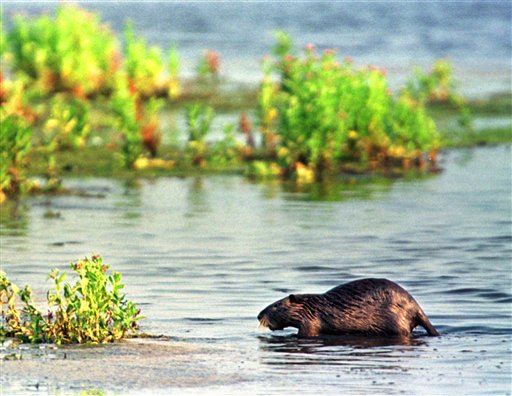
(AP) A water-loving rodent native to South America that has destroyed thousands of acres of wetlands in the southeast has been spotted near Lake Washington.
Nutria are semi-aquatic, chocolate-colored rodents that can weigh more than 20 pounds and eat one-quarter of their weight a day in crops and plants of all varieties. Also called coypu, or swamp rats, they burrow through marshes and levies, and females can produce more than a dozen offspring a year.
A trapper recently caught nine along the shores of Lake Washington. Two University of Washington students are studying the rodents to determine where they may show up next.
"It's a pretty ominous picture when you bring nutria into an area where they didn't exist before," said Mike Davison, a wildlife biologist with the state Department of Fish and Wildlife. "There is no way of winning on this if nutria establish."
A statewide Invasive Species Council was recently created to track nutria and other invasive plant and animal species, and to find methods for removing them.
The council will include six state agencies and two counties and will work with federal and other government agencies, business, tribal and nonprofit groups. It plans to meet in coming months.
"Having an Invasive Species Council is a big step forward," said Joan Cabreza, invasive species coordinator with the Northwest regional office of the U.S. Environmental Protection Agency.
Washington has lagged behind states like Oregon and Idaho that already have such councils that work to prevent introduction of invasive species. Without such a council, no single agency had the authority to act, Cabreza said.
"If you can get on these things early and get people to understand how important it is, the impact is really small," said Bill Brookreson, deputy director for the state Agriculture Department.
Nationally, nutria are found in at least 15 states, including Louisiana, Texas, the Carolinas, Florida, Maryland and Oregon.
In the 1930s and '40s, they were raised in Washington and elsewhere for their fur. They're vulnerable to cold and flooding, though, and it's believed they died out of the Puget Sound region over the years.
Populations have established in southwest Washington, near Vancouver, where they've turned local dikes to "Swiss cheese," said Davison.
Last summer, more than a dozen were caught in Skagit County in a state-led control effort.
Davison helped in the project in Skagit County, where agricultural and forestry industries and reliance on levies make the area vulnerable to the pests. Traps are still being laid and nutria caught are killed.
Milder weather could have helped the nutria spread into the Puget Sound area, as well as a lack of predators like caiman and alligators in their native environment.
Armed with large packs, camera gear and notebooks, UW students Phu Van and Filip Tkaczyk are documenting where the interlopers are living, how many there are and what they're eating. They're focusing on an area of fields and wetlands north of Husky Stadium.
Along the shoreline, the large rodents have flattened grass and cattails, creating "runways" as they travel from the water to dens to fields where they graze among the Canada geese.
Ed Cunningham, a Highline High School educator who also runs a trapping business, was called this winter by a Lake Washington resident who wanted the rodents removed.
He used bait and wire cages to trap nine of the rodents over a couple of weeks in February and March.
"What we need to do is get some sterile alligators that like cold water," joked Cunningham. "I'm not going to get them all."




1 comment:
Oddly enough I found this trying to figure out what these guys were. I fairly certain I've seen 4 of them within 3 hours along the shore of Silver Lake in Medical Lake, WA. They looked exactly as in the picture but they had trouble getting onto the ice. - March 19, 2008
Post a Comment